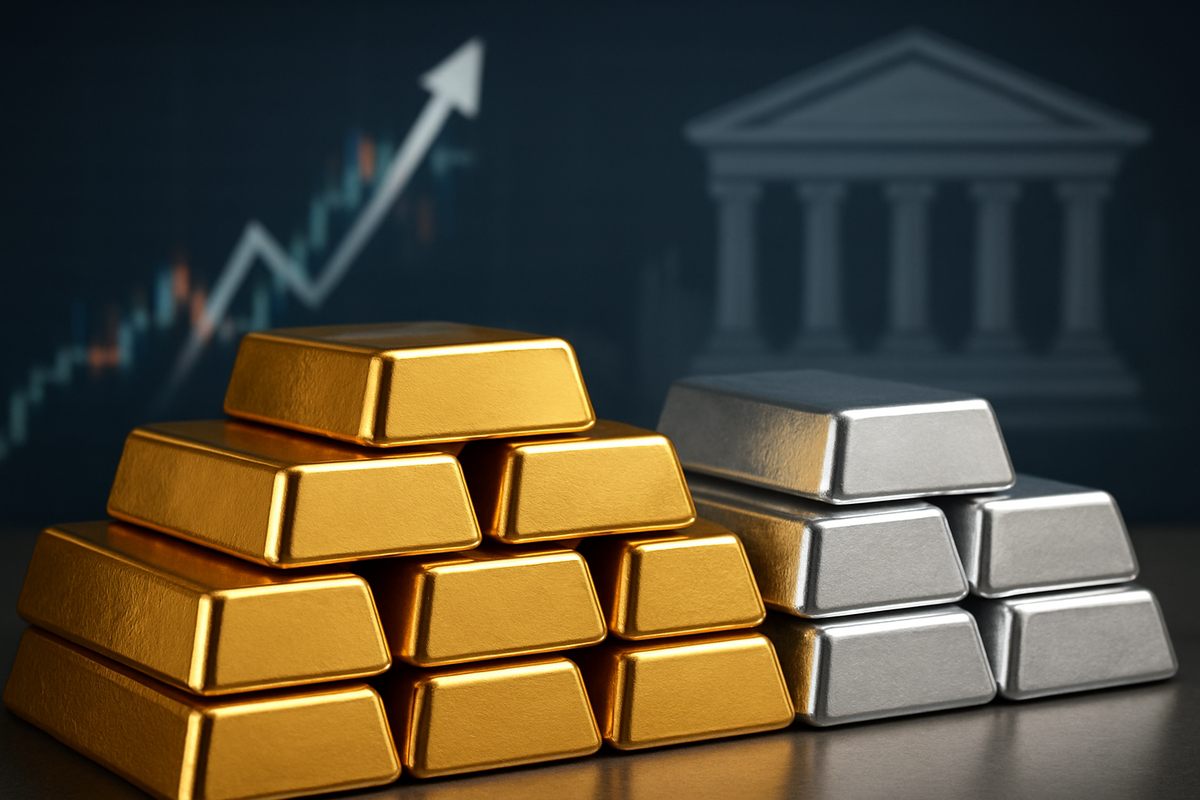
In a stunning display of market resilience and investor anticipation, both gold and silver have shattered previous records in late 2025, reaching unprecedented highs as the U.S. Federal Reserve's pivotal interest rate decision looms. This remarkable resurgence in precious metals is not merely a fleeting moment but reflects a deeper narrative of economic uncertainty, strategic central bank maneuvers, and a palpable shift in global financial sentiment. With the market overwhelmingly betting on an imminent rate cut, the luster of gold and silver has never been brighter, signaling a potential paradigm shift in investment strategies.
The rally, which gained significant momentum through October and November, underscores a growing inclination among investors towards safe-haven assets amidst a backdrop of geopolitical tensions and softening economic indicators. As the world watches the Federal Reserve for its next move, the record-breaking ascent of these metals serves as a powerful barometer of market anxiety and the perceived need for tangible stores of value in an increasingly volatile financial landscape. The implications are far-reaching, promising to reshape portfolios and influence monetary policy discussions worldwide.
Unprecedented Heights: A Detailed Look at the Precious Metals Phenomenon
The closing months of 2025 have etched a new chapter in the history of precious metals, with both gold and silver achieving extraordinary milestones. Gold, the perennial safe haven, breached the $4,300 per ounce mark in October, specifically hitting an all-time high of approximately $4,382 on October 20th. This momentum continued into November, with spot prices consistently hovering above $4,100 per ounce, even reaching $4,175 on November 25th and settling around $4,151.70 on November 26th, 2025. This represents a staggering 58% year-to-date gain for the yellow metal.
Silver, often referred to as "poor man's gold," has not only followed suit but, in some respects, outperformed its shinier counterpart. The white metal surged to an all-time high of $54.49 in October 2025, with a record-high close of $53.46 on November 12th. By November 26th, silver had climbed to $52.50 USD per troy ounce, marking a 2.00% increase from the previous day and an impressive 12.13% rise over the past month. Its year-to-date increase of 74% highlights a dual appeal: its traditional safe-haven role combined with burgeoning industrial demand from AI-related technology, smartphones, and green energy initiatives, which has led to noticeable supply shortages.
The primary catalyst for this historic rally is the overwhelming expectation of a U.S. Federal Reserve interest rate cut in December 2025. Market probabilities, as tracked by the CME FedWatch tool, surged from 40% to 79-85% for a December cut between November 21st and 26th. This dovish shift has been heavily influenced by recent commentary from influential Fed officials, including New York Fed President John Williams and Fed Governor Christopher Waller, who have hinted at the possibility of trimming rates without jeopardizing inflation targets.
Further bolstering this sentiment is a stream of softer-than-expected U.S. economic data, including weaker retail sales, declining consumer confidence, and signs of a cooling labor market. These indicators provide the Fed with the necessary justification to ease monetary policy, which in turn reduces the opportunity cost of holding non-yielding assets like gold and silver, making them significantly more attractive to investors. Beyond speculative plays, central banks globally are also playing a crucial role, projected to acquire over 900 tons of gold in 2025, surpassing demand from other sectors and providing a robust institutional floor under prices. The weakening U.S. dollar further enhances the appeal of these dollar-denominated commodities for international buyers.
Companies on the Cusp: Winners and Losers in the Precious Metals Boom
The unprecedented surge in gold and silver prices is set to create distinct winners and losers across various industries, profoundly impacting public companies tied to these commodities and broader economic trends.
Foremost among the beneficiaries are precious metals mining companies. Gold and silver producers stand to see a significant boost in their revenues and profit margins as the value of their output skyrockets. Companies like Barrick Gold Corp. (NYSE: GOLD), Newmont Corporation (NYSE: NEM), Agnico Eagle Mines Limited (NYSE: AEM), and Pan American Silver Corp. (NASDAQ: PAAS) are poised for substantial gains. Higher metal prices mean that even marginal mines become more profitable, potentially leading to increased exploration budgets, expanded production, and improved financial health. Investors in these companies could see strong stock performance, dividend increases, and share buybacks as cash flows improve. Furthermore, junior exploration companies with promising gold and silver deposits might find it easier to attract capital for development.
Conversely, companies heavily reliant on a strong U.S. dollar or those with significant exposure to rising input costs (which can be a consequence of the inflationary pressures often associated with rising gold prices and a weakening dollar) might face headwinds. While a weakening dollar makes precious metals more attractive, it can make imports more expensive for U.S.-based companies. Additionally, if the Federal Reserve's anticipated rate cuts are a response to a slowing economy, then companies in cyclical sectors like retail, manufacturing, or discretionary consumer goods might experience reduced demand, impacting their bottom lines. Financial institutions that have significant exposure to interest-rate sensitive assets could also face challenges if the cuts are deeper or more prolonged than expected, compressing net interest margins.
The industrial demand for silver, particularly from high-tech sectors, also creates a unique dynamic. Companies involved in the production of solar panels, electric vehicles, and advanced electronics might face higher raw material costs for silver. While these industries are growing, a sharp increase in silver prices could squeeze their profit margins unless they can pass on these costs to consumers or find alternative materials. However, for companies that are already well-hedged or have long-term supply agreements, the impact might be mitigated. Furthermore, the overall market sentiment driven by the Fed's dovish stance and economic uncertainty could lead to a broader flight to quality, potentially diverting capital from riskier growth stocks towards more stable, dividend-paying companies or those in defensive sectors, affecting the valuation of high-growth tech firms that are not directly involved in precious metals.
Wider Significance: A Reflection of Global Economic Shifts
The current surge in gold and silver prices is far more than a simple market fluctuation; it is a profound reflection of broader industry trends and shifting global economic paradigms. This event fits squarely into the narrative of increasing safe-haven demand, driven by persistent geopolitical instability, such as ongoing Russia-Ukraine talks, and widespread economic jitters. The anticipation of Federal Reserve rate cuts, fueled by cooling inflation signals and softer economic data, further solidifies the appeal of non-yielding assets. This trend underscores a growing lack of confidence in traditional fiat currencies and interest-bearing instruments when real returns are perceived to be negative or diminishing.
The ripple effects of this precious metals boom are extensive. For competitors and partners in the mining sector, higher prices can spur increased exploration and production, potentially leading to greater competition for resources and labor. However, it also creates opportunities for mergers and acquisitions as larger players seek to consolidate lucrative assets. For other industries, particularly those reliant on global supply chains, a weakening U.S. dollar—a key factor in the metals' rise—can make international trade more complex and potentially more expensive for U.S. importers, while benefiting exporters. The industrial demand for silver, particularly from burgeoning sectors like AI, solar, and electric vehicles, highlights its dual role as both a monetary and an industrial metal, intertwining its fate with technological advancements and green energy transitions.
Regulatory and policy implications are significant, primarily centering on the Federal Reserve's monetary policy. A sustained period of low interest rates or aggressive rate cuts, as anticipated, could lead to concerns about inflation, potentially prompting central banks to reconsider their long-term strategies. The ongoing accumulation of gold by central banks globally, projected to exceed 900 tons in 2025, signals a deliberate move towards diversifying reserves and hedging against currency instability, a policy shift that could have lasting impacts on the international financial system. Historically, periods of economic uncertainty and monetary easing have often coincided with strong performance in precious metals, drawing parallels to the post-2008 financial crisis era and other periods of high inflation or geopolitical stress. These historical precedents suggest that the current rally might be more than a temporary blip, indicating a more structural shift in investment preferences towards tangible assets.
What Comes Next: Navigating the Future of Precious Metals
The immediate future of gold and silver prices hinges significantly on the Federal Reserve's upcoming decision and subsequent monetary policy trajectory. In the short term, if the Fed delivers the anticipated rate cut in December 2025, precious metals are likely to receive another strong bullish impulse, potentially pushing them even higher. Any hawkish surprises or deviations from the expected dovish stance, however, could introduce significant volatility and lead to a temporary pullback. Investors should closely monitor the Fed's forward guidance, as well as upcoming economic data releases, including inflation reports and employment figures, which will provide further clues about the central bank's long-term strategy.
In the long term, the outlook for precious metals appears robust. Analysts from institutions like Bank of America project gold to average $4,538 per ounce in 2026, with a potential climb to $5,000, supported by ongoing macroeconomic uncertainties and persistent safe-haven demand. UBS echoes this sentiment, projecting gold reaching $4,200 per ounce based on anticipated Federal Reserve rate cuts. Silver, with its dual role as a monetary and industrial metal, is also expected to maintain its upward trajectory, particularly as demand from AI, solar, and electric vehicle sectors continues to grow, potentially exacerbating supply shortages.
Potential strategic pivots for investors include increasing allocations to precious metals as a hedge against inflation and currency debasement, especially if global central banks continue their dovish policies. Diversification into precious metals exchange-traded funds (ETFs) or direct ownership of physical bullion could become more prevalent. Mining companies might strategically pivot towards expanding high-grade operations or acquiring new deposits to capitalize on elevated prices. Market opportunities may emerge in exploration and development of new mines, as well as in technology that improves mining efficiency or reduces environmental impact. Challenges include potential market corrections if economic conditions unexpectedly improve or if central banks adopt a more hawkish stance than currently anticipated.
Potential scenarios range from a continued "gold rush" if global economic uncertainty persists and interest rates remain low, to periods of consolidation if economic data stabilizes. A "black swan" event, such as a major geopolitical escalation or an unforeseen economic crisis, could further amplify the safe-haven demand for gold and silver, driving them to unprecedented levels. Conversely, a rapid and sustained global economic recovery, coupled with aggressive monetary tightening, could temper the rally. Investors should prepare for various outcomes, emphasizing portfolio resilience and a balanced approach that accounts for both the upside potential and downside risks.
Comprehensive Wrap-Up: A New Era for Precious Metals
The soaring prices of gold and silver to record highs in late 2025 mark a significant juncture in the financial markets, underscoring a powerful confluence of factors that have propelled these ancient stores of value into the modern investment spotlight. The primary takeaway is the profound impact of the impending Federal Reserve decision, with overwhelming market expectations of a December rate cut acting as the primary catalyst. This dovish shift, driven by softening economic data and explicit signals from Fed officials, has dramatically reduced the opportunity cost of holding non-yielding precious metals, making them exceptionally attractive in the current low-yield environment.
Moving forward, the market is poised for continued vigilance, with the Federal Reserve's actions and global economic indicators dictating the pace and direction of precious metals. The sustained institutional buying by central banks, coupled with robust industrial demand for silver from cutting-edge technologies, suggests that this rally is not merely speculative but rooted in fundamental shifts in global financial strategy and industrial needs. Investors should recognize the dual nature of silver, benefiting from both its safe-haven appeal and its critical role in the technological revolution.
The lasting impact of this event could usher in a new era where precious metals play an even more prominent role in diversified portfolios, serving as a crucial hedge against inflation, geopolitical instability, and currency volatility. The current environment reinforces the timeless appeal of gold and silver as tangible assets in an increasingly digital and uncertain world. Investors should closely watch for further announcements from central banks, global inflation trends, and any shifts in geopolitical landscapes. Monitoring the performance of mining companies and the demand trends from high-tech industries will also provide valuable insights into the ongoing trajectory of this precious metals resurgence in the months to come.
This content is intended for informational purposes only and is not financial advice







